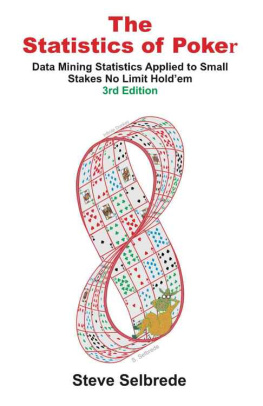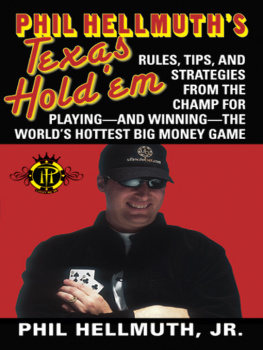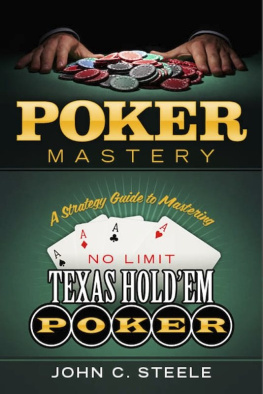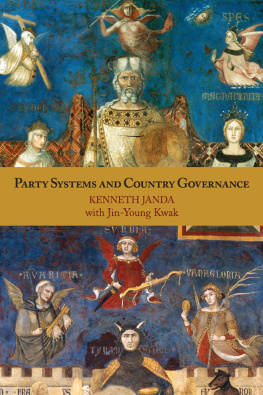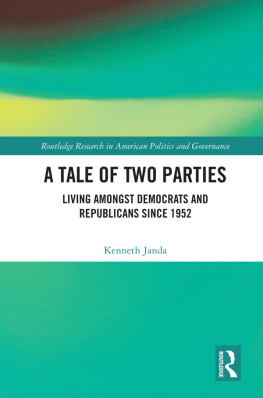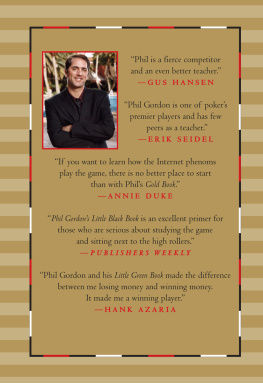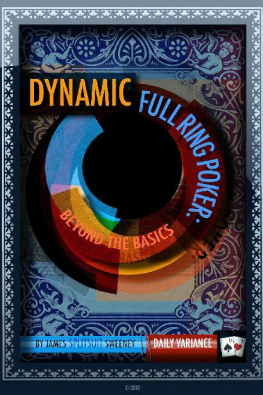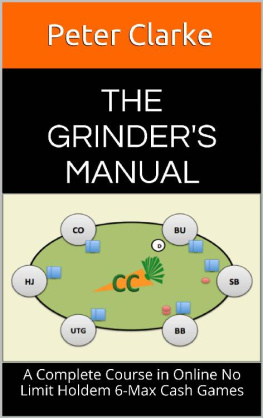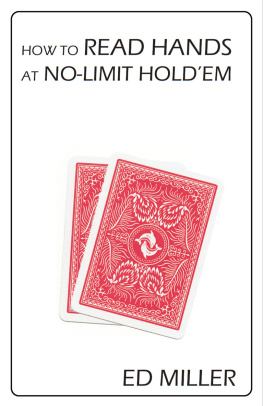Janda - APPLICATIONS of No-Limit Holdem
Here you can read online Janda - APPLICATIONS of No-Limit Holdem full text of the book (entire story) in english for free. Download pdf and epub, get meaning, cover and reviews about this ebook. year: 2013, publisher: Two plus Two, genre: Home and family. Description of the work, (preface) as well as reviews are available. Best literature library LitArk.com created for fans of good reading and offers a wide selection of genres:
Romance novel
Science fiction
Adventure
Detective
Science
History
Home and family
Prose
Art
Politics
Computer
Non-fiction
Religion
Business
Children
Humor
Choose a favorite category and find really read worthwhile books. Enjoy immersion in the world of imagination, feel the emotions of the characters or learn something new for yourself, make an fascinating discovery.
- Book:APPLICATIONS of No-Limit Holdem
- Author:
- Publisher:Two plus Two
- Genre:
- Year:2013
- Rating:4 / 5
- Favourites:Add to favourites
- Your mark:
- 80
- 1
- 2
- 3
- 4
- 5
APPLICATIONS of No-Limit Holdem: summary, description and annotation
We offer to read an annotation, description, summary or preface (depends on what the author of the book "APPLICATIONS of No-Limit Holdem" wrote himself). If you haven't found the necessary information about the book — write in the comments, we will try to find it.
Janda: author's other books
Who wrote APPLICATIONS of No-Limit Holdem? Find out the surname, the name of the author of the book and a list of all author's works by series.
APPLICATIONS of No-Limit Holdem — read online for free the complete book (whole text) full work
Below is the text of the book, divided by pages. System saving the place of the last page read, allows you to conveniently read the book "APPLICATIONS of No-Limit Holdem" online for free, without having to search again every time where you left off. Put a bookmark, and you can go to the page where you finished reading at any time.
Font size:
Interval:
Bookmark:
Applications of
No-Limit Hold em
A Guide to
Understanding Theoretical Sound Poker
By
M ATTHEW J ANDA
A product of
Two Plus Two Publishing LLC

FIRST EDITION
FIRST PRINTING
May 2013
Printing and Binding
Creel Printers, Inc.
Las Vegas, Nevada
Printed in the United States of America
Applications of No-Limit Hold em
A Guide to
Understanding Theoretically Sound Poker
COPYRIGHT 2013
Two Plus Two Publishing LLC
All rights reserved.
Printed in the United States of America.
No part of this book may be reproduced or transmitted in any form, by any means, electronic or mechanical, including photocopying and recording, or by any information storage or retrieval system without the express permission in writing from the publisher.
For information contact:
Two Plus Two Publishing LLC
32 Commerce Center Drive
Suite H-89
Henderson, NV 89014
ISBN: 1-880685-55-8
ISBN13: 978-1-880685-55-6
About Matthew Janda
Matthew Janda has had an interest in card games his entire life, and began playing poker with friends in high school before playing online cash games in college. While originally studying business economics at UCLA, a game theory course sparked his interest in poker theory and optimal play.
Currently, Matthew continues to make poker training videos for CardRunners and all of his videos are theory based and designed to teach players the math necessary for improving their play without going into unnecessary or impractical details. Hes never been one to discuss what line is best with a specific hand, but rather uses computer programs to display what action he thinks is best with each hand in his entire range.
Matthew is applying for medical school in 2013 and hopes to be a physician one day. Hes currently finishing up his required science classes and volunteering, but poker remains his favorite hobby.
Acknowledgements
Perhaps the most rewarding aspect of playing poker was all the amazing people I got to know over the last several years, many of whom deserve recognition for making this book possible. Their input and encouragement allowed me to continue forward even at times when it appeared the project was beyond my abilities. While there are far too many to name, Jaime Kaplan, Matt Groves, Nick Hall, Roy Bhasin, Michael Marinakis, and Nick Howard have all been especially important to me over my poker career. Additionally, without the help of Johannes Nowak in the early stages of this book, Im nearly positive it would not be produced in its current form. And lastly, Ive been very fortunate to have the opportunity to discuss poker with Ben Sulsky, as few players will ever understand the game as well as he does, much less be able to implement complex strategies so effectively.
Ive also been extremely lucky to have the support of the staff and community at CardRunners. Their positive response to my poker theory videos is ultimately what inspired me to undertake such a large project, and without their consistent enthusiasm, its likely I would have given up at some point.
Additionally, Id like to thank Mason Malmuth and David Sklansky of TwoPlusTwo Publishing LLC. Creating this book from the initial manuscript required a tremendous amount of work from Mason, and his professionalism and work ethic were crucial in allowing us to complete the project in a timely manner. Plus, Davids comments and insights into advanced aspects of poker proved invaluable. Its been a pleasure working with both of them, and thanks to their help, Ive improved tremendously as a writer. And after working with Two Plus Two, I cant imagine working with any other publishing company.
The fantastic cover illustration, which I feel does a great job capturing the essence of the content in this book, is the work of Russell Acton who won the Cover Design Contest on www.twoplustwo.com and who posts as ninetynine99. I also need to thank Gary Alstatt of Creel Printing for additional graphics throughout the book.
The program Flopzilla was especially useful for analyzing hand examples, so Id like to thank Scylla for creating this excellent program. It can be found at www.flopzilla.com.
For the index, I need to thank Carol Roberts of Roberts Indexing Services. Her website is located at www.RobertsIndexing.com.
Lastly, Id like to thank my friends and family, especially my parents, who always encouraged me to pursue my goals. Its much easier to complete a large project with the support of those you care most about.
A Cautionary Note
About Bluff Catching
by Mason Malmuth and David Sklansky
Because we at Two Plus Two know that many of the readers of this book are presently intermediate players who play against non-experts, we felt that it was necessary to add an important point regarding this advanced text.
One of the main aspects of Game Theory Optimal Play that Matthew Janda emphasizes is that you should usually strive to stop your opponent from showing a profit if he were to bet all of his hands. From this axiom, he derives many of his strategies.
To keep an opponent from gaining from constantly bluffing profitably you need to make a lot of calls with mediocre hands. That is, hands which are only bluff catchers since they wont beat a legitimate bet.
Our concern is that those of you who are not playing against experts may not realize that the calling strategy that Janda assumes may be too loose for your game. For instance, if your opponent bets the pot, you should theoretically call with about half your hands which usually include many weaker ones.
Janda mentions a few theoretical exceptions. But the biggest exception occurs in games that Janda doesnt usually address. Namely games when you are playing against players who are very tight or very timid. So if your opponent bets the pot in a situation where, even before he bet, you thought he was a big favorite to have a monster, bluff catching calls will just lose money. Similarly, if you are against someone who will often be beaten, it makes no difference if you know he almost never bluffs. Hence, if he bets, you should almost always fold. (Well, probably not always since that may teach him to change his ways.)
Introduction
This book is designed to develop and explain the math and theory behind no-limit Texas hold em with extra emphasis placed on how the game should be played against perfect, or theoretically optimal, opponents. It will show how many winning players approach the game and with talent and hard work, give the tools needed to continue to develop as a player.
Many of the concepts in this book have been largely ignored by the poker community, and the few players who understand them usually like to keep this information private. On the other hand, many winning players are not even aware these concepts exist since they are not required to beat strong opponents. However, difficult concepts shouldnt be ignored if your goal is to slowly tune your game closer to game theoretically optimal with the purpose of moving up in stakes and beating other strong players. While its true no-limit hold em is far from a solved game, players who understand theory well will usually be the players best able to recognize and exploit their opponents mistakes and make sure their opponents are not able to easily exploit them.
The theory and hand examples all focus on 6-max. This game is my specialty where Ive played almost all of my hands. Nevertheless, nearly all the concepts discussed will be transferable to 9-max and heads-up games. The majority of the theory will even be useful in other poker games such as Omaha.
Next pageFont size:
Interval:
Bookmark:
Similar books «APPLICATIONS of No-Limit Holdem»
Look at similar books to APPLICATIONS of No-Limit Holdem. We have selected literature similar in name and meaning in the hope of providing readers with more options to find new, interesting, not yet read works.
Discussion, reviews of the book APPLICATIONS of No-Limit Holdem and just readers' own opinions. Leave your comments, write what you think about the work, its meaning or the main characters. Specify what exactly you liked and what you didn't like, and why you think so.


